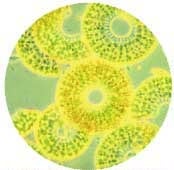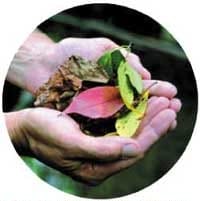Microbes and Molecules

Most of us experience streams through our five senses. We hear the sounds the water makes as it runs over rocks, we feel its coolness when we dip our hand, and while it is no longer a recommended activity, we once tasted it when we slaked our thirst. Many modern rivers are identifiable by their odors. Perhaps most of all, we experience a stream with our eyes, watching the play of sunlight on its surface or a fish taking a fly.
What we can’t see, at least without the help of a good microscope, is the teeming world of tiny organisms that sustain the stream’s life and health. It is as if we were to go to New York and marvel at the huge buildings, while the millions of people who are the lifeblood of the city remain invisible. Yet as many as a billion bacteria, plus millions of protozoa and hundreds of thousands of diatoms, occupy a square centimeter of a streambed, and the collective efforts of such microorganisms provide or process most of the energy that supports the visible life of the stream.
Almost all the biologically useful energy on Earth comes from plant life. Some of it is consumed directly, but most dies and decays. Fungi and bacteria decompose the decaying matter, and in the process they cycle essential nutrients back to a mineral form to be consumed again by algae. The decomposers are, in turn, eaten by larger organisms in an ongoing process that returns much of the original energy back to the food chain.

Since the period of the Rockefeller grant, studies at Stroud™ Water Research Center have pioneered the investigation of energy flow in streams. By teasing apart and reassembling a stream’s web of microscopic components, Stroud scientists have sought to describe its unseen life.
Thomas Bott, Ph.D., led the way with his efforts to quantify the role of algae in the food web and of bacteria and fungi in degrading leaf litter. Chemist Rick Larson was simultaneously analyzing the organic chemistry of the water.
When Louis Kaplan, Ph.D., came to the Stroud Center he joined the other two scientists in exploring the linkages among watershed processes, dissolved organic matter and bacterial production. In the course of that work, they applied to freshwater systems a concept known as the “microbial loop,” which had been developed in marine studies. It suggested that bacteria play a vital role in the food web by using organic matter excreted by algae and becoming a direct food resource for more complex organisms.
These early investigations have advanced in two directions:
- What happens to the bacteria and how important is the transfer of energy through microscopic animals to higher organisms such as insects and fish?
- What is the chemical structure of dissolved organic matter and how does it influence the availability of food to groups of decomposers?
Both strands build on the insights gained from the Rockefeller studies and the River Continuum Concept. Their goal is to understand the critical relationship between land and water in stream ecology and to describe the interconnectedness of microorganisms with the visible members of aquatic communities in our streams and rivers.
